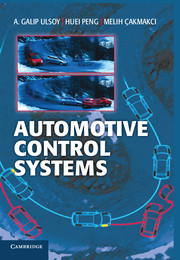Book contents
- Frontmatter
- Contents
- Preface
- Part I Introduction and Background
- Part II Powertrain Control Systems
- 6 Air–Fuel Ratio Control
- 7 Control of Spark Timing
- 8 Idle-Speed Control
- 9 Transmission Control
- 10 Control of Hybrid Vehicles
- 11 Modeling and Control of Fuel Cells for Vehicles
- Part III Vehicle Control Systems
- Part IV Intelligent Transportation Systems
- Appendices
- Index
- References
9 - Transmission Control
Published online by Cambridge University Press: 05 June 2012
- Frontmatter
- Contents
- Preface
- Part I Introduction and Background
- Part II Powertrain Control Systems
- 6 Air–Fuel Ratio Control
- 7 Control of Spark Timing
- 8 Idle-Speed Control
- 9 Transmission Control
- 10 Control of Hybrid Vehicles
- 11 Modeling and Control of Fuel Cells for Vehicles
- Part III Vehicle Control Systems
- Part IV Intelligent Transportation Systems
- Appendices
- Index
- References
Summary
Automotive transmissions are a key element in the powertrain that connects the power source to the drive wheels. To improve fuel economy, reduce emissions, and enhance drivability, many new technologies have been introduced in automotive transmissions in recent years (Sun & Hebbale 2005). Electronic control of automatic and continuously variable transmissions (CVTs) is considered briefly in this chapter, as well as the related topic of clutch control for AWD vehicles.
Electronic Transmission Control
Electronically controlled transmissions (ECT) are used to improve fuel economy, performance, drivability, and shift quality. It even may be possible – because of the flexibility provided by microcomputer software – to allow for “adaptive” shift schedules, which can be tailored for improved fuel economy, performance, or comfort. Because of the flexibility offered in ECT, the industry is seeing an accelerated trend away from traditional mechanical/hydraulic transmission control and a move toward the integrated ECT/engine/traction/speed control functions. In the following discussion, the major benefits of ECT are illustrated:
Precise Lockup Control. Historically, vehicles with an automatic transmission usually are about 10 percent less efficient than those with a manual transmission. The efficiency loss arises mainly from the slip of the torque converter. Torque-converter lockup has been used widely to improve fuel economy. With electronic control, it is possible to coordinate shift point, lockup schedule, and accurate timing of lockup release to reduce shock at gear shifting. Consequently, in recent years, the fuel economy of an ECT is only slightly worse than for a manual transmission.
Better Shift Quality. For the same reasons, clutch pressures can be controlled for improved shift quality. Coordinating with the engine-control unit (i.e., reducing engine torque during gear shifting) can improve substantially shift quality and reduce shock load on shift elements.
Flexible Driving. Different gear-shift patterns (e.g., power and economy) can be selected by a driver to better adapt to driving conditions. In general, if the information is available, the shift schedule can be programmed to consider vehicle status (e.g., warm-up and load), driving conditions (e.g., local or highway), and even driver status (e.g., passive or aggressive).
Weight Reduction. Both size and weight can be reduced because of reduced complexity. The number of component parts also was found to be greatly reduced, which is translated into higher reliability and lower cost.
Integrated Vehicle Control. Engine, cruise, and traction control functions can be integrated for superior performance.
Foolproof Design. Improper operation by a driver (e.g., down shifting or shifting into reverse gear at high vehicle speed) can be detected to avoid severe damage to the transmission.
- Type
- Chapter
- Information
- Automotive Control Systems , pp. 131 - 147Publisher: Cambridge University PressPrint publication year: 2012

